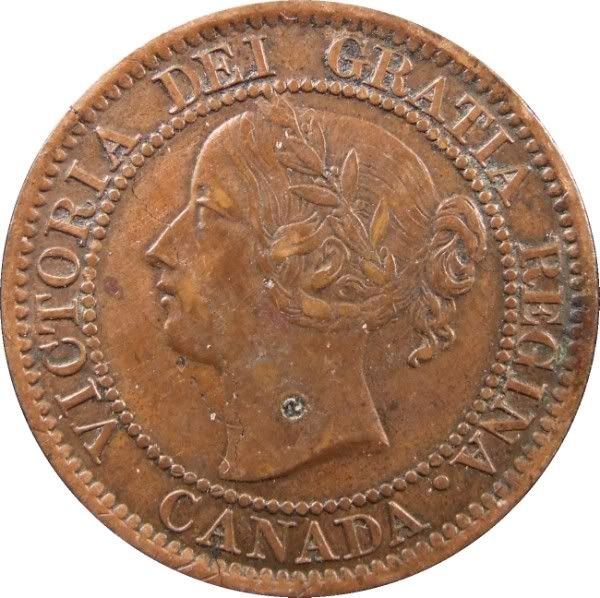Saturday, December 31, 2011
Happy New Year
I'm wishing you all a Happy New Year and good hunting for the coins you are after. I've made some of the articles I have published in the past available in case you have missed them when they originally published. Click on the Published Article link at the top of the right hand navigator under "Pages" to access them. Enjoy!
Sunday, November 20, 2011
Sharing Your Knowledge Nets You More
I was having a casual conversation with a friend of mine a while back, covering this and that, nothing in particular. The conversation rolled around to coins. Now my friend is not a collector and they know that this topic with me can suck up most of the oxygen in the room once I get started. Sometimes I think people just ask to be polite. Kind of like saying “how are you today?” You don’t really want to know all the ailments that are afflicting them, you are having polite conversation.
This conversation starts with “How are your pennies doing?”
How do I answer that? I don’t call them pennies, I never have. They say CENT right on them so I know they are cents. Also, it’s large cents I collect, and specifically Victoria that I specialize in.
“They are great” I say, “I’m learning gobs from looking at them.”
My friend does market research for a living so she understands the concept of knowledge extraction from a data set. In my case this means that I’m laying out a group of coins for study, cataloging them in a normal fashion for grade, and then looking closer at each coin to determine its particular characteristics. These also get cataloged, the coin gets photographed if needed, markers noted and then the coin gets placed back in my ‘study’ binder in a fashion that I can find it again. Every few new dies I identify, I need to print of the new photographs and place them in the appropriate place in the growing catalog. This process of iteration takes quite some time to work through, but since there is no reference work for what I am doing this “catalog on the fly” approach does work. The bigger my catalog gets, the easier it is to identify what I find. The new die’s I discover get fewer and fewer the bigger my sample set grows.
“How will you share your results?” she asks. “You can’t keep that stuff to yourself; you need to spread the knowledge around.”
This causes a tangent discussion on published articles, e-books, good old hard copy, costs, barriers, publishers, market size, demand, need, apps, Twitter, blog’s, social networks, copyright, copyright infringement, and a host of other things. Eventually we roll back around to the coins. Actually it’s the people around the coins we talk about.
I have a network of friends that specialize in Vickies as well. We share thoughts and new finds back and forth. We proof each other’s work when we are getting ready to publish books or articles. We explore theories by exploring our coin sets against a hypothesis. But it’s the larger population, beyond the specialists that’s important. The bigger question for us is ‘what are we doing to share our knowledge’?
The more I’ve found ways to share what I know, the more I have received in return. I have met some wonderful collectors, specialists and friends. I have all sorts of people I interact with in discussion boards with funny screen names. I receive emails for people I’ve never met asking questions on Vickies. The more I share it seems, the more I get back in friendship, knowledge, perspective, opportunity and such. Only in a very few cases with a couple of people was it to my detriment to share. By and large the most rewarding aspect of what I do with my coins is sharing my knowledge.
My experience in this leads me to the following few points that I live by;
- Respect others intellectual and physical property
- Ask for help when you need it
- Share what you know in a manner you are comfortable with
- Write an article for a web site, RCNA Journal, local club newsletter etc.
- Introduce your children, grandchildren, nieces and nephews, the kid down the block etc. to your passion
- Share your finds, but never gloat
- Teach, you learn far more when you need to teach something to some one
- Never just take, always give back
So, how are your pennies doing? Find a way to let us all know what you are working on and what you have found.
 |
| 1876 Study group and developing catalog. The binder holds north of 500 coins all individually documented to build the growing catalog on the left. |
Saturday, November 5, 2011
Do You Specialize?
I was at a coin store the other day that I had not been to before. It looked like a nice place and the dealer was pleasant. As I was looking around at the mostly US offerings, (I live in the states) the dealer approached and asked me if he could help. Cutting right to the chase I said “sure, do you have any Canadian large cents?” This question usually brings an answer of “no, sorry, what else do you collect?” Sometimes I get “yes I have a few here somewhere”. That response is usually followed by some rummaging around to produce a handful of low grade common date stuff anywhere from 1859 to 1920, with the emphasis on George.
1888 – I see this as a great opportunity for study. We all know that there are tons of repunched 8’s and the mintage numbers mean that we won’t be finding them all for a while.
All Others – This groups coins from 1892 forward to 1901. I used to think that there was not much going on here but there are lots of double punched numbers in the dates and various date spacing’s.
This particular day, I got asked some qualifying questions in return. “What dates are you interested in? Are you looking for grade or circs? I think I have a few certified as well, are you interested in those?” OK I seem to be interfacing with a dealer that has stock. This is unusual for me. His questions really forced me to get more specific in my wants.
“I’m really just looking for Victoria” comes my response.
He counters “What dates do still need?” OK, I’m going to have to get more specific.
“I don’t really need any dates, I just collect Victoria.”
“Oh, I have a selection of better grades, would you be interested in those?”
“It depends on the date.” I say. At this point he is continuing to be very nice as he attempts to pull out of me what I actually want. I find myself almost frustrated. Not at the dealer, but at the fact that I apparently don’t seem to know what I want. I’m going to have to step up my game here. “I’m focused on earlier dates at the moment, anything from 1858 through about 84 or so”.
“Ah, I have a number of 1859’s and some of the earlier ones, all circs, is that OK?”
“Yes that would be great!”
As he heads to the back room to get the appropriate box, it occurs to me that there are easy groupings that large cents fall into. It’s not just that I am a large cent collector; I have groupings that I seem to pay attention to. For instance I will by George, but I tend to stay BU. Almost the same for Edward, I work AU and up. These are nice groupings and one could easily specialize by king. For Victoria, well, she seems to fragment much the way Liberty does on early US copper. For Victoria, the groupings that seem natural to me are;
1858 – This is an outstanding variety year to collect. Rob Turner has opened the collecting world’s eyes to this group. The drawback is the coins are not pocket change. Most collectors have 1 or 2 of these, not gobs of them. I’m working on a variety set so I have several at the moment.
1859/8 – This is the short series. There are only a few varieties in this group. I had a full set of all the Obv. and Rev. combinations until Rob Turner published 1 other. I’m in the hunt for it now as well.
1859’s – I’m not sure what to say about this group. There are so many different ways that one could collect this date it is almost a single collecting focus in itself. Brad Gravestone did a ton of work on these and Dr. Jim Haxby is currently in the process of publishing the die varieties. For me, I like the re-punched 9’s and 5’s
I want to break the Dominion group by Obverse but I find that too restrictive so here is how I see it.
Obv. 1x – All the Obv. 1, 1a, 1a/1 coins from 1876 to 1886. This is a nice 5 year group with some spectacular varieties to look for. Since the 84 and 86 Obv. 1 and 1a coin are single dies for those years it is really a 3 year group.
Early Obv. 2 – I group the 1882-1887’s together as well as the Obv. 2/1 stuff.
1888 – I see this as a great opportunity for study. We all know that there are tons of repunched 8’s and the mintage numbers mean that we won’t be finding them all for a while.
Obv. 3 - All 3 years
1891 – All combinations of Obverse and reverse. There are lots of varieties here if you wanted to go for the entire set. You’ll need a guide for this. Look to Rob Turner for this series.
All Others – This groups coins from 1892 forward to 1901. I used to think that there was not much going on here but there are lots of double punched numbers in the dates and various date spacing’s.
Heaton – Collect just H coins including the 1907
Is it any wonder that I had a hard time articulating what I wanted to look at! I ended up buying some nicer circ 1859’s and an 81. I’ll need to be more prepared next time I visit this particular shop. It’s nice to have choice but sometimes you really need to have focus on what your targets are. Specializing in certain areas of large cents can be an outstanding way to broaden your collection. Pick an area and dive in!
Wednesday, August 31, 2011
Ugly Coins and Technical Grading
OK I needed to take a bit of a break but I’m back. Over the summer I’ve managed to make it to the RCNA show in Windsor and the ANA show in Chicago. Both were great events, I met some good people and saw some great coins. I even bought a few. Oddly I bought more at the ANA show than the RCNA show. To be fair, there was more choice for the items I was looking for at the ANA show so that is why I purchased more there.
Both shows however got me thinking about grading. The Canadian show featured coins using a technical grading standard (ICCS mostly) while the US show featured coins using market grading (all the major TPG’s). The difference put simply is that in the US the TPG’s also take into consideration eye appeal and strike as well as the technical aspects. So a coin with better strike and stunning eye appeal gets a bump in grade and should sell for more money, or so the story goes. I’m not sure how I feel about that but I do think pretty coins look better than ugly coins.
That brings me to the topic of this post. I think I tend to fall into the technical grading arena for the most part. However I will always tend to select a better looking coin at the same grade over a shoddy looking example. I’m not talking about grade within a grade, and by that what I mean is passing a low end MS63 to get a high end MS63. I’m talking about what a coin looks like. For example, on a MS coin classified as “Red”, I like it to actually be “Red” without carbon spots, finger prints etc. Nothing turns me off a mint state coin quicker than a big old thumb print, a few carbon spots, and a coin that looks more Red Brown than Red. I’ll pass every time on those. I’ll also pass on a VF 30 coin with distracting marks in favour of one that has fewer marks. Where the marks are does make a difference to me. Vicky can hide a mark in her hair an awful lot better than a gash across her throat!
If the coin is raw, then my mental check list of things I’m looking at proceeds as normal and I can make a decision on the coin. This tendency of mine to prefer better looking coins causes me problems if the coin has been slabbed. You might think that odd but let me explain. When I’m looking at a technical graded coin, I have to “factor in” the market grading steps of eye appeal and strike to get me to a decision point on the coin. So far so good right? Leave the ugly one and buy the pretty one. This is harder to do on line. The pics generally feature the holder not the coin, so it’s harder for me to make this assessment. When I’m looking at a market graded coin, I’m “factoring out” eye appeal and strike to back down to a technical grade. Why would I do that? If the coin was grade bumped to take into account those items, I want to establish for myself what I think the technical grade of the coin is. This is a lot of work to make a decision on a coin.
Sunday, May 8, 2011
Chinese Counterfeits – Part 2 - 1858’s
This is the second of a two part series. The first article provides the background for this one so if you have not yet read it, you should start with that one first, and then finish here. This article will give you the tools to spot a Chinese counterfeit 1858 Victoria large cent. Since the basic markers are the same between the 1859 and the 1858, this discussion only focuses on the differences specific to the 1858.
Obverse Markers
The 1858 Chinese counterfeit large cent was based on the 1859 model. The exact same obverse was used for the 1858 that they used for the 1859. Victoria’s nose however has had work. There is a prominent bump at the bridge where they have attempted to strengthen her portrait. You can use all the same markers from the 1859 to identify the 1858 as counterfeit. Furthermore, this obverse die was never used on the real 1858’s so if you see one with these markers it is 100% counterfeit
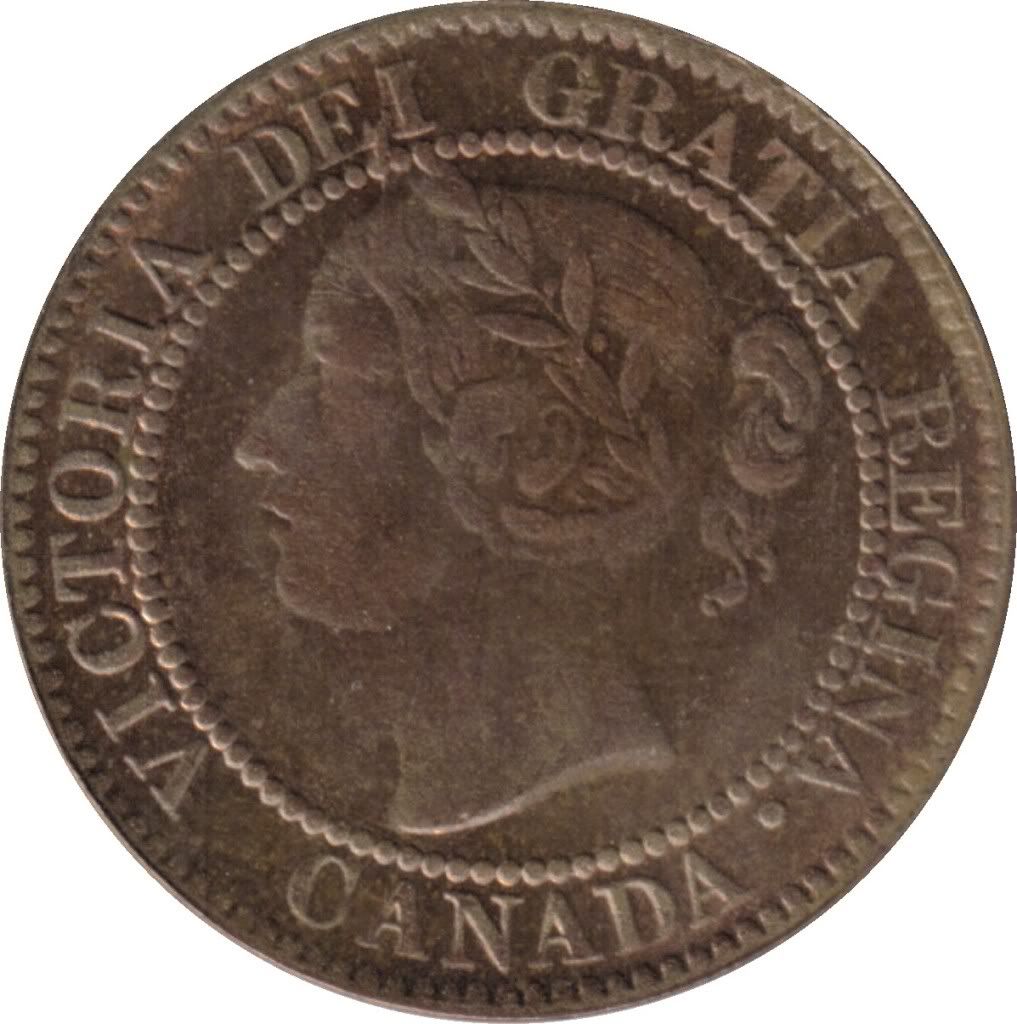 |
| Fig. 1: Counterfeit 1858 coin from Big Tree Coin Factory, obverse. Photo courtesy of Mike Marshal, used here with permission. |
Reverse Markers
The reverse used for the 1858 Chinese counterfeit large cent was also based on the 1859 model. They however did remove the entire date and then re-cut the new one into the die. The result is an 1859 die crack pattern with an 1858 date. The font used for the digits in the date is also completely wrong for an 1858 large cent and it stands out like a sore thumb. The left side of the T in CENT is missing, as if from a filled die.
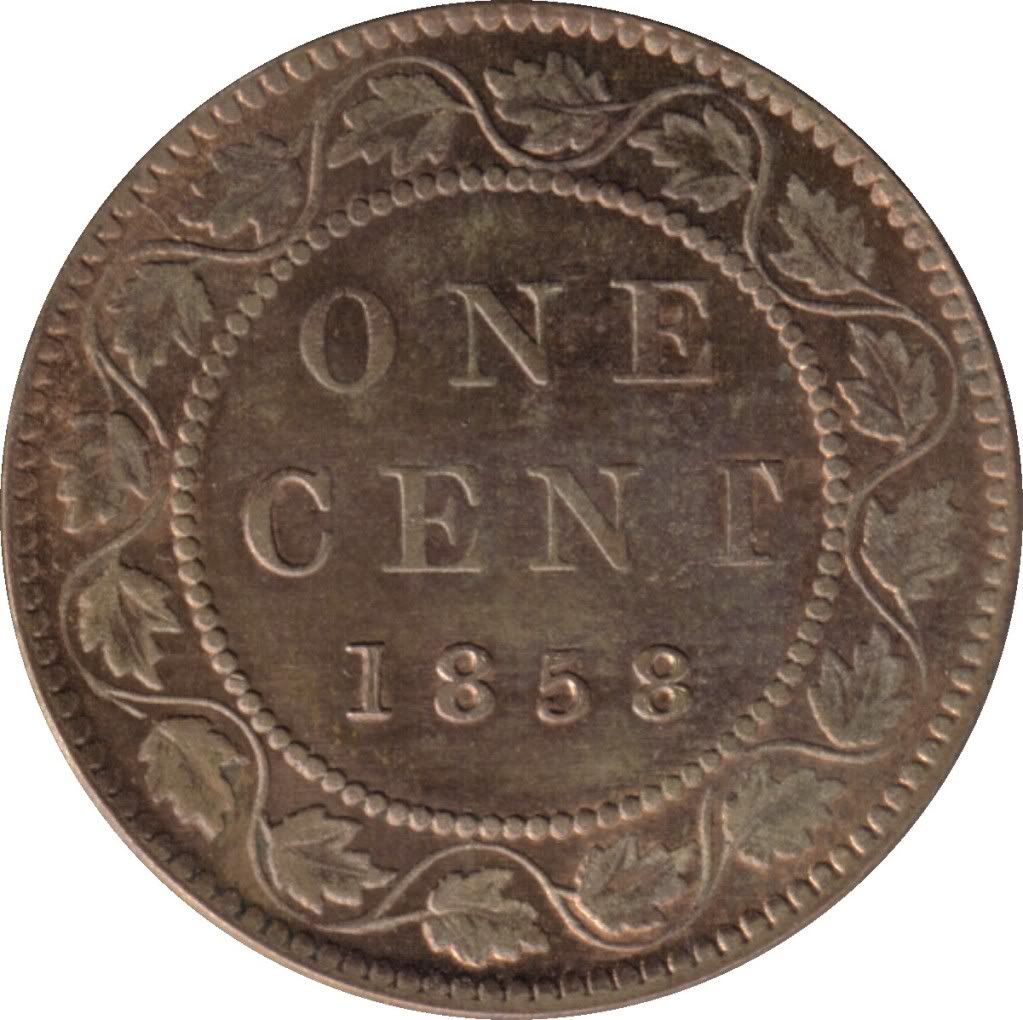 |
| Fig. 2: Counterfeit 1858 coin from Big Tree Coin Factory, reverse. Photo courtesy of Mike Marshal, used here with permission. |
Here is my short list of items to identify the 1858 counterfeit large cents coming from China.
Chinese Counterfeit
Will never be a higher grade than seen in photo.
Will not have Vicky crud in the devices.
Will not have 160 years of patina.
Will have a colour that will make you pause.
The coin will look to be softly struck.
Vicky has had a nose job, resulting in a bump at the bridge of her nose.
The obverse is exactly the same as that use for 1859.
The reverse has exactly the same die cracks as that found for 1859.
The entire date has been re-cut into the working die using the wrong font.
The T in CENT is missing the upper left side.
Will never be a higher grade than seen in photo.
Will not have Vicky crud in the devices.
Will not have 160 years of patina.
Will have a colour that will make you pause.
The coin will look to be softly struck.
Vicky has had a nose job, resulting in a bump at the bridge of her nose.
The obverse is exactly the same as that use for 1859.
The reverse has exactly the same die cracks as that found for 1859.
The entire date has been re-cut into the working die using the wrong font.
The T in CENT is missing the upper left side.
Real coin
There is no real coin for 1858 with any of these characteristics.
There is no real coin for 1858 with any of these characteristics.
The big “tell” here is the date. The counterfeit coins all have the wrong font used for the digits on a large cent. This sticks out like a sore thumb. When you see one of these, compare the obverse and reverse to the notes on the 1859 counterfeit, and the markers will be the same. All 1858 coins in the market place with these characteristics on the obverse and reverse are counterfeit. Save your hard earned cash for a real coin.
The big issue with the 1858 Chinese counterfeit is that the die crack at DEI looks similar to one found on a real obverse used in 1858. That coin was featured in the large cent variety section of the Charlton Standard Catalogue of Canadian Coins, Volume One, Numismatic Issues 2011, 65th Edition. At a quick glance, the die crack on the counterfeit in this location looks very similar to the die crack and chip on the real 1858. Don’t be fooled.
Stay on your guard and learn the markers. The photos below compare the date and the die crack at DEI of real 1858’s against the Chinese counterfeits. The die cracks and the date are the keys!
Thanks to Mike Marshal for graciously permitting the use of his photos of the counterfeit coin. More counterfeit coin photos from Mike can be found at the RCMP web site and the CCRS web site. It’s worth your effort to become familiar with the markers on your collecting interests.
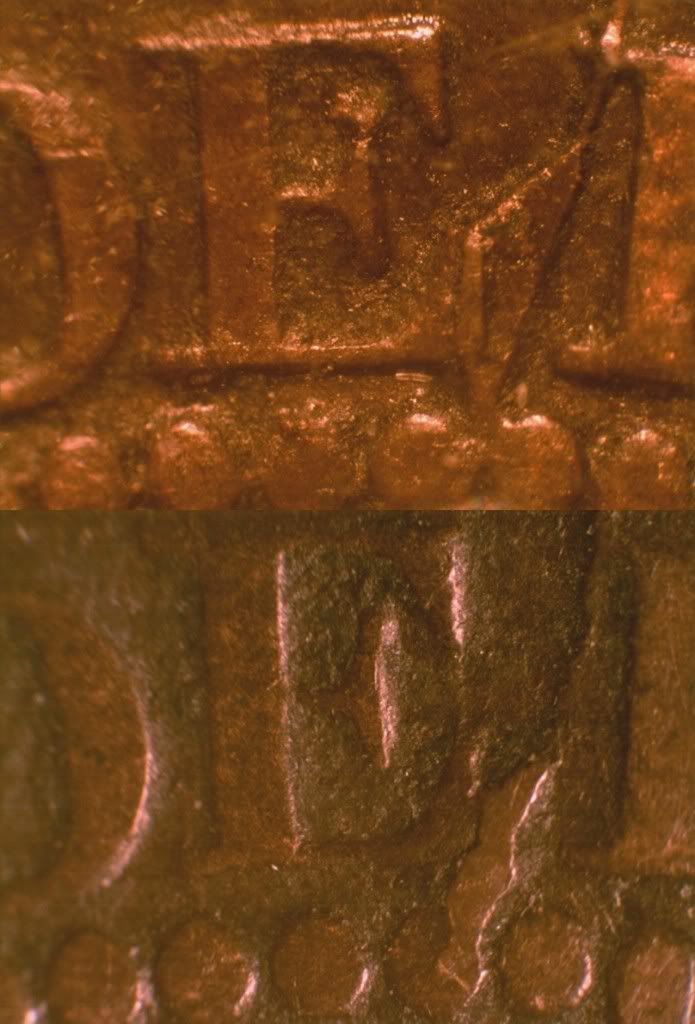 |
| Fig. 4: The die crack and chip from a real 1858 coin is shown at the top. The die crack that is on the counterfeit is similar but not the same and is shown below. |
Labels:
1858,
big tree coin factory,
counterfeit,
fake coin,
Mike Marshal
Saturday, May 7, 2011
Chinese Counterfeits – Part 1 - 1859’s
Over the last few years counterfeit coins from China have made their way to Canada and the USA via several routes including online auctions. The internet discussion boards were all a buzz on the issues and potential difficulties with these counterfeits entering the North American marketplace. Standing against the wave of counterfeit Canadian coins was Mike Marshal. Mike worked diligently on documenting the identification points and photographing known counterfeit coins. His efforts with the RCMP have essentially stemmed the tide of counterfeit Canadian coins from China making their way to Canada. We all owe Mike a debt of gratitude for his tremendous efforts.
The initial onslaught appears to be over, however Chinese counterfeit coins are here. How can we identify them so we are not deceived when we make our next purchase. They may be offered for sale with the full knowledge of the seller that they are counterfeit. It is also possible that they come to market through estate sales etc. where the seller doesn’t realize what they are. In any case, our ability as consumers to be able to detect a counterfeit coin is an important skill to develop. This article explores the counterfeit 1859 cents from China in a manner that should allow collectors to be able to detect counterfeits and avoid them.
The Chinese counterfeit outfits start with real coins as their models. This means that the characteristics of that original real coin are carried through to the dies and ultimately the counterfeit coins. For us, that gives us the markers to look for. The photos below of the counterfeit obverse and reverse and have been provided courtesy of Mike Marshal and are use here with permission.
Obverse Markers
There are 5 die cracks and a misshapen bead that will easily allow you to identify this obverse. The most distinctive features are the crack between EI of DEI, the crack at the I in REGINA and the misshapen bead at the G in REGINA that is fused to the G with a die chip. The other 3 cracks are at the C in VICTORIA and the G in GRATIA and the N in CANADA.
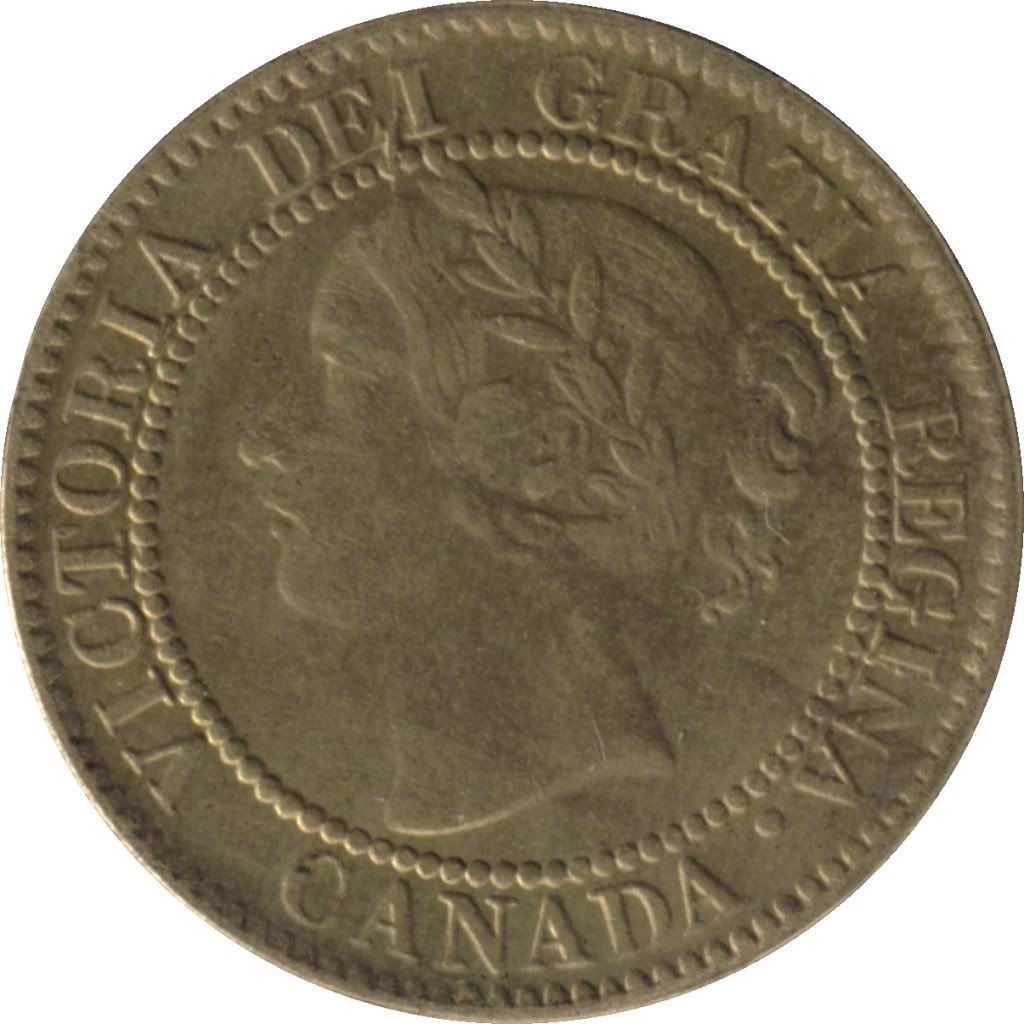 |
| Fig. 1: Counterfeit 1859 coin from Big Tree Coin Factory, obverse. Photo courtesy of Mike Marshal, used here with permission. |
There are 3 markers on the reverse side of these coins that we can use. On the counterfeit, the gap at L7 is wide, the stem at L8 is present, and the vine at L2 is closed. Both the L8 stem and the L2 vine are re-engraving efforts on the original coin. In addition, there are 2 die cracks to look for. The first is a heavy crack running from a denticle by the tip of L15 to the vine at the stem of L14. The second is a much lighter crack and runs from a denticle to the stem of L10, on through the bead line and up to the 1 in the date.
 |
| Fig. 2: Counterfeit 1859 coin from Big Tree Coin Factory, reverse. Photo courtesy of Mike Marshal, used here with permission. |
Not all coins in the market place with these characteristics are counterfeit. There are at least 6 different real reverses associated with the single real obverse used on the counterfeit coins. Only the one with the markers as indicated above are suspect. When you are looking at a coin with both the obverse and reverse markers, you are now faced with trying to determine if it is one of the real coins, or a Chinese counterfeit. Here is my short list of items to help you decide.
Chinese Counterfeit
Will never be a higher grade than seen in photo.
Will not have Vicky crud in the devices.
Will not have 160 years of patina.
Will have a colour that will make you pause.
The coin will look to be softly struck.
Vicky has had a nose job.
Will never be a higher grade than seen in photo.
Will not have Vicky crud in the devices.
Will not have 160 years of patina.
Will have a colour that will make you pause.
The coin will look to be softly struck.
Vicky has had a nose job.
Real coin
Will be seen across many grades.
Will have Vicky crud if a circ. unless the coin has been cleaned.
Will have a nice patina unless the coin has been cleaned.
Will be chocolate brown unless the coin has been cleaned.
The coin will look to be fully struck.
Vicky has her original nose.
Will be seen across many grades.
Will have Vicky crud if a circ. unless the coin has been cleaned.
Will have a nice patina unless the coin has been cleaned.
Will be chocolate brown unless the coin has been cleaned.
The coin will look to be fully struck.
Vicky has her original nose.
The big thing here is the nose. The counterfeits are softly struck and the nose just fades away into the field along the bridge and at the nostril.
No one wants to put out good money for counterfeit material so you need to be able to recognize a counterfeit when you see it. You might be thinking, what’s all the fuss about a worn 1859 narrow 9? The reason this particular 1859 is such a problem is that many 1859 variety collectors prize the full stem at L8 and will pay a premium for it. The second reason is that this counterfeit has shown up in on line auctions as “brass”. Now that’s big bucks!
Stay on your guard and learn the markers. The photos below are from an example of the real coin that was used as the model for the counterfeit. I’ve taken some close ups of the “tells” from my real coin so you can get a good idea of what to be looking for as the markers to be wary of. The nose is the key!
Thanks to Mike Marshal for graciously permitting the use of his photos of the counterfeit coin. More counterfeit coin photos from Mike can be found at the RCMP web site and the CCRS web site. It’s worth your effort to become familiar with the markers on your collecting interests.
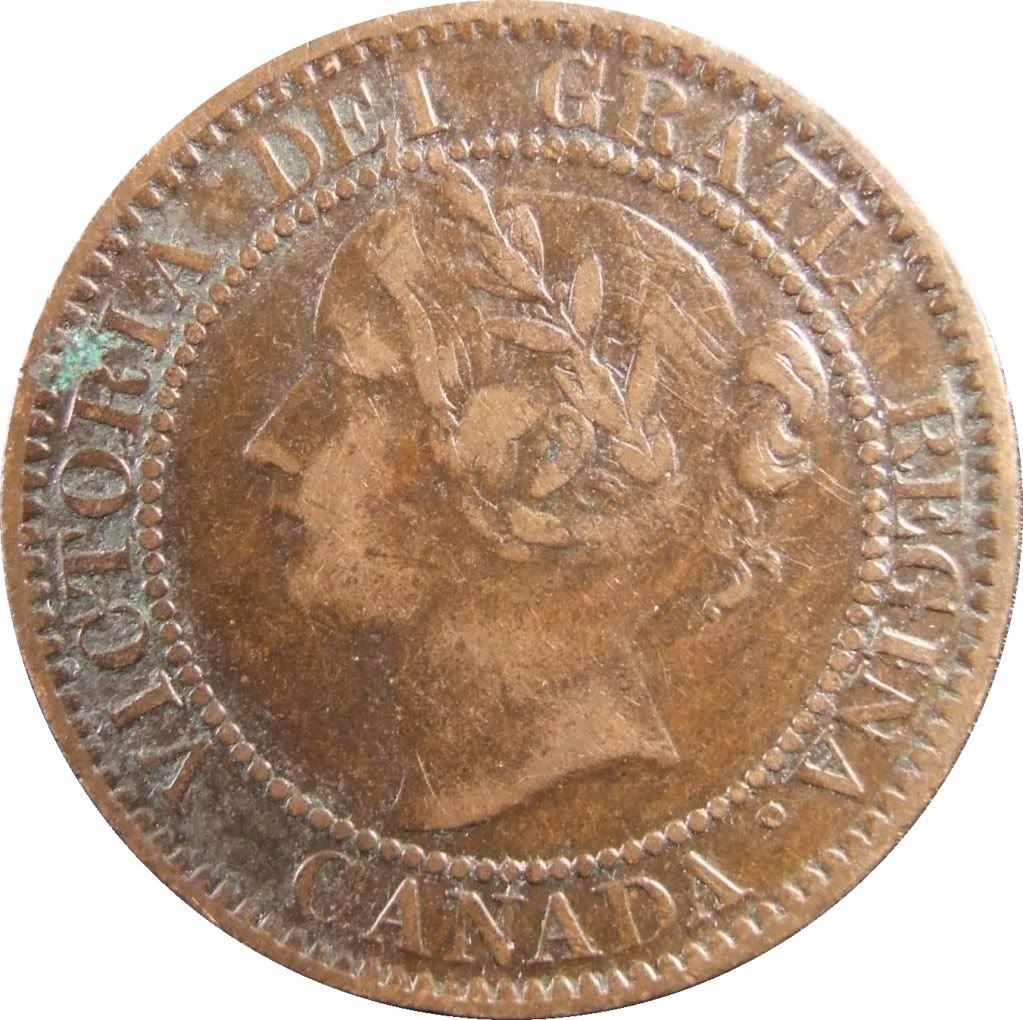 |
| Fig. 3: Real 1859 coin with same obverse of the Chinese counterfeit. |
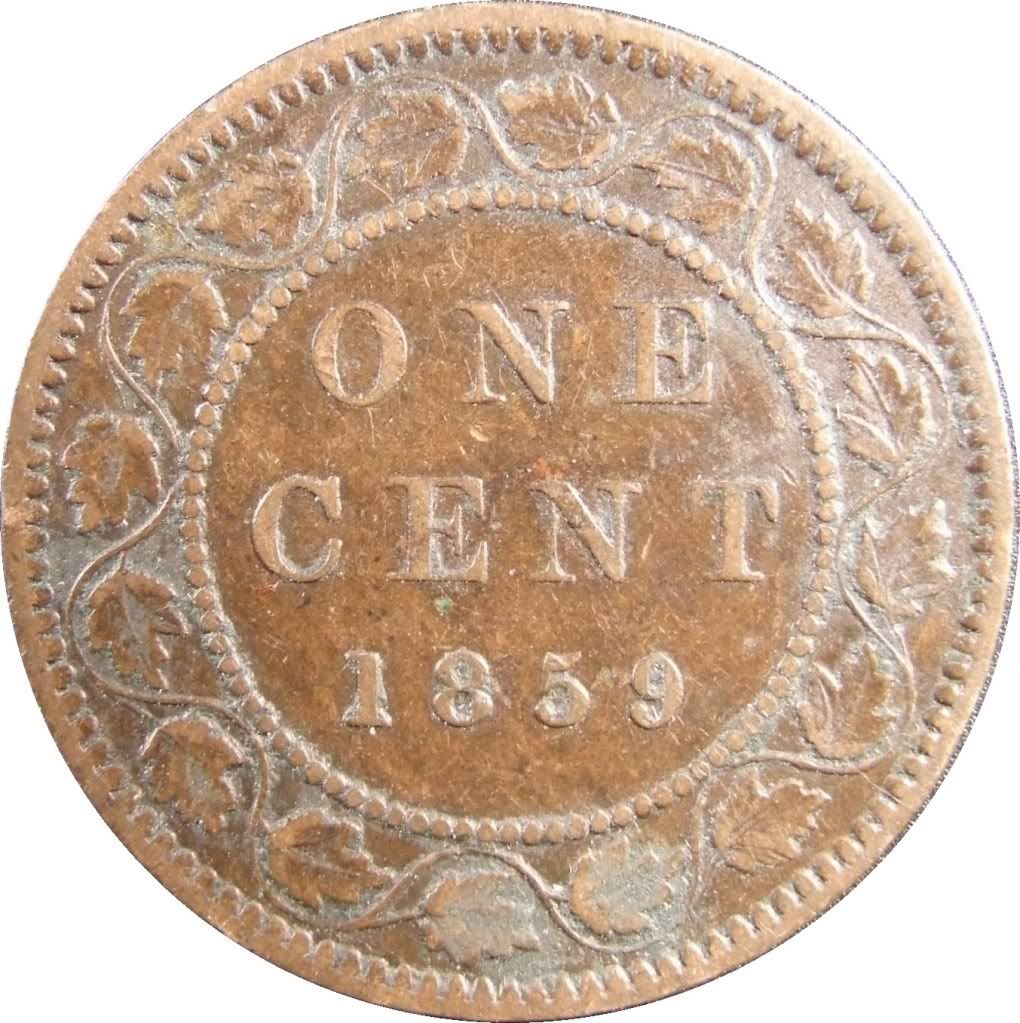 |
| Fig. 4: Real 1859 coin with same reverse of the Chinese counterfeit. |
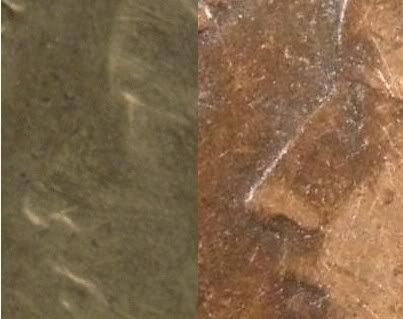 |
| Fig. 5: Counterfeit on the left, the nose fades into the field, at the bridge and the nostril. Real coin on the right for comparison. |
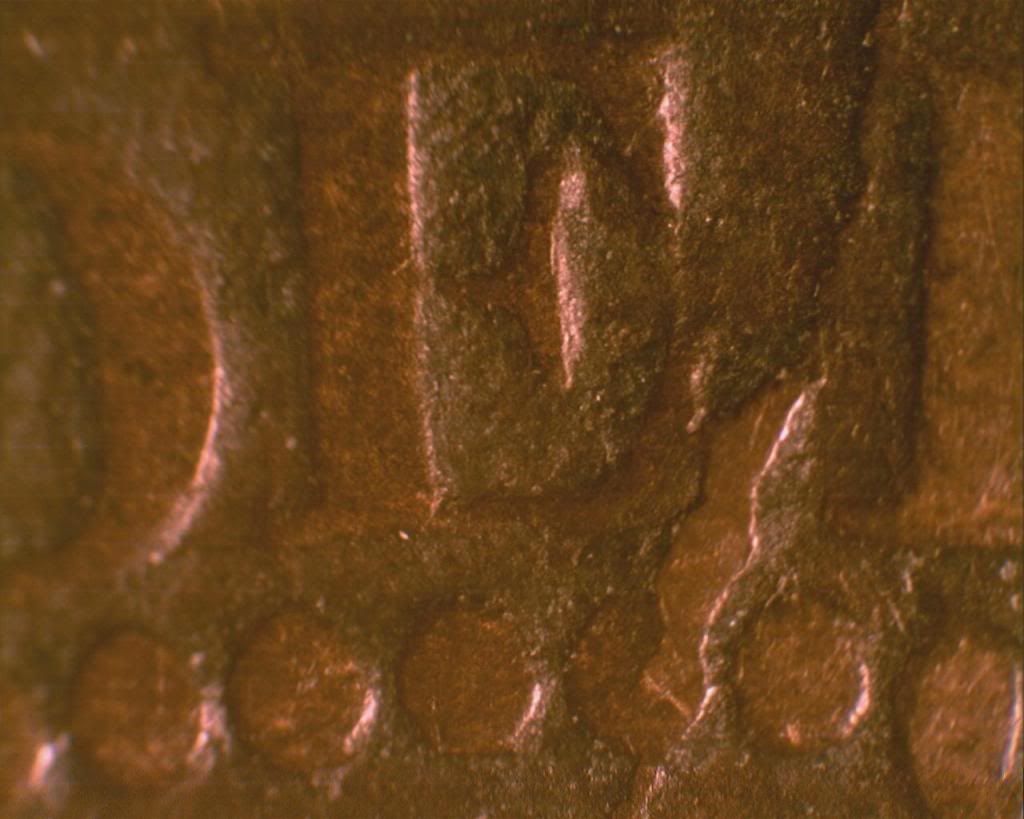 |
| Fig. 6: Die crack at DEI. |
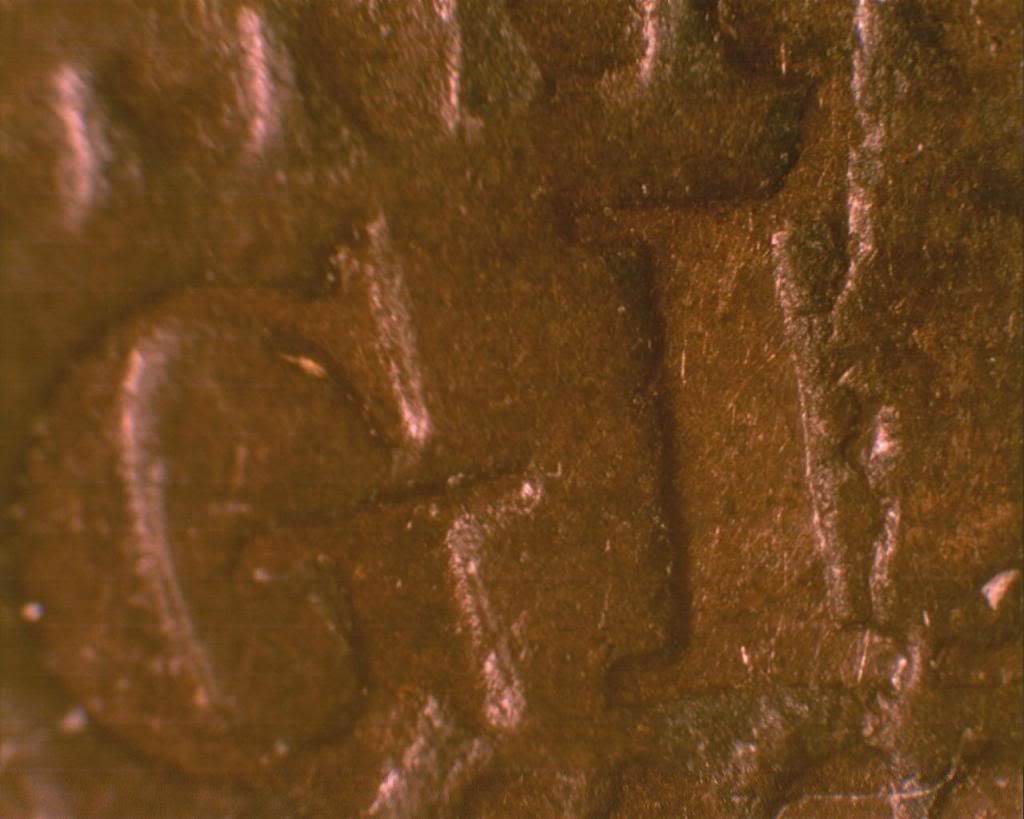 |
| Fig. 7: Die crack at I in REGINA. |
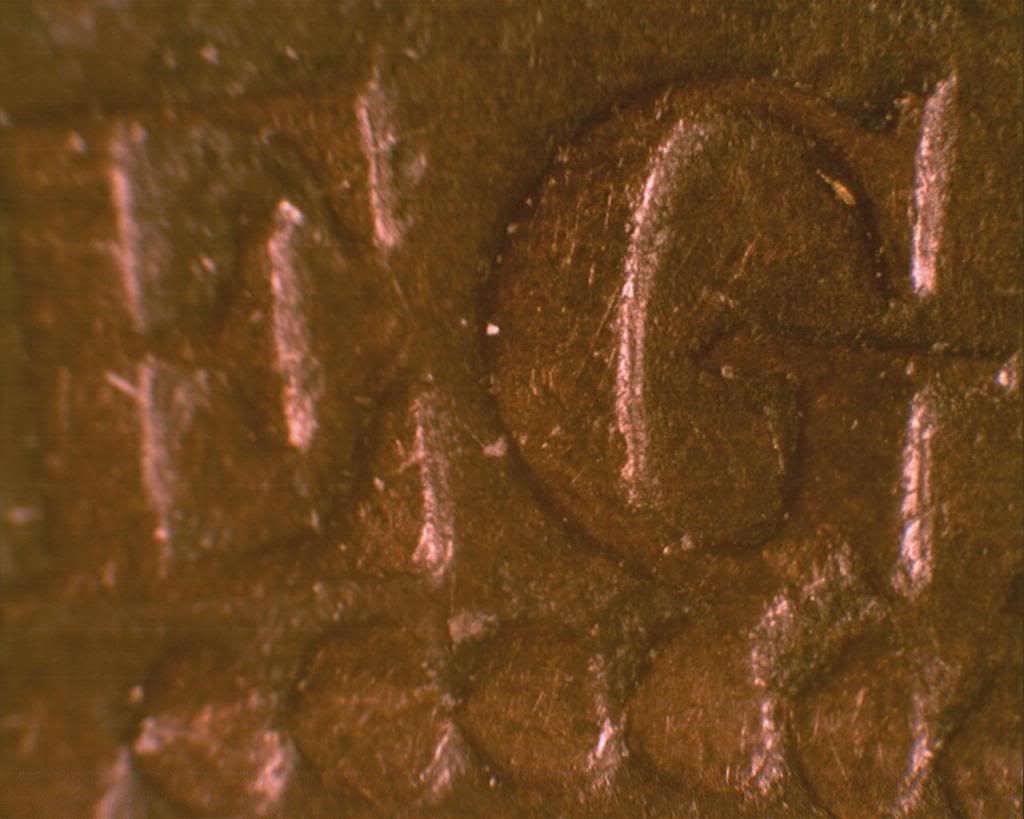 |
| Fig. 8: Misshapen bead at G in REGINA showing the die chip fusing the bead and the G. |
 |
| Fig. 9: Die crack across the tip of L15 to the vine at the stem of L 14. |
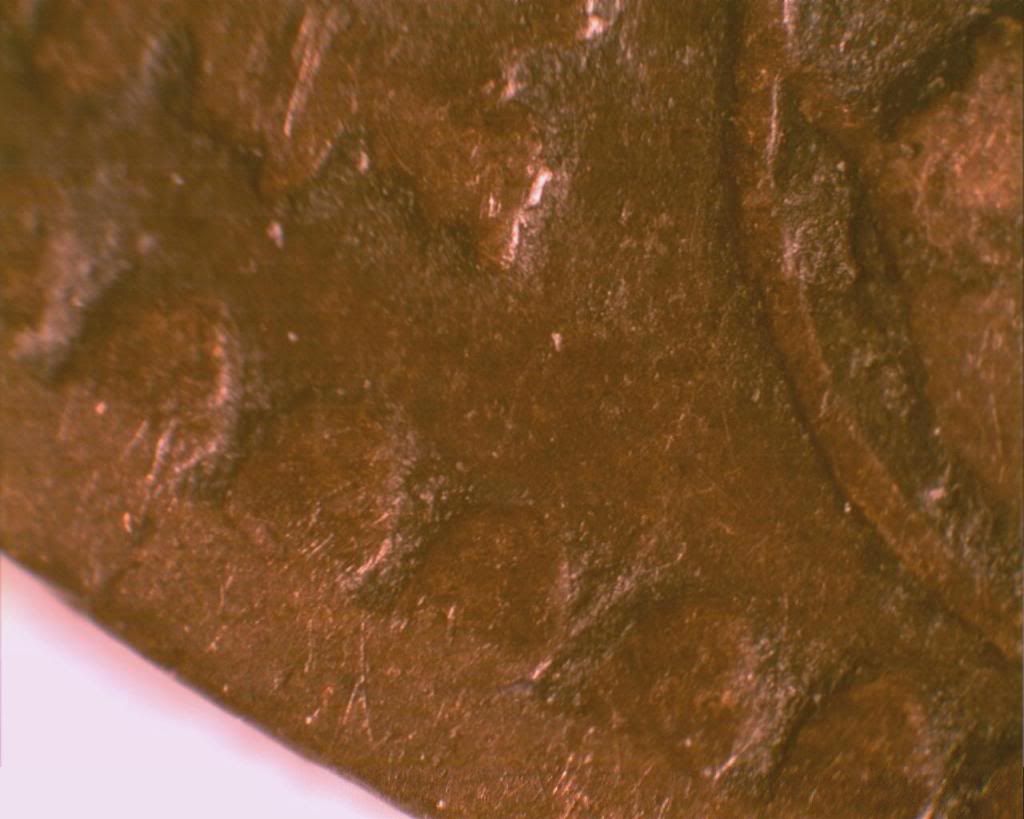 |
| Fig. 10: Die crack from the denticle to the stem at L10. |
Labels:
1859,
big tree coin factory,
counterfeit,
fake coin,
Mike Marshal
Saturday, April 23, 2011
The Last 1859 over 8, or That Final Wide 9
It came this week. The last 1859 over 8 that I needed to complete my set. According to “The 1858 Cents of Provincial Canada, Vol. II” by Rob Turner, there are 12 known different reverses and 13 known different obverses that make up a set of wide 9 over 8’s. They combine to yield 18 coin pairings. That is a complete set. Charlton highlighted 3 of this group in 65 Edition, in the large cent variety section.
The coin that came this week is an RD8/OG2. It was the last one I needed to complete the set. It’s a nice one too! I had only seen 1 other but I was not quick enough to snag it. To get this one, I traded a scarce 1858 die pairing variety for it. I think that trading may well be a great avenue to secure some of the scarcer die pairings. I like to keep traders of the more difficult coins from any given year. In doing so, I have coins to trade with that someone may well need and want. This takes me back years to when I was a kid with a mitt full of hockey cards. Playing “got ‘em, got ‘em, need ‘em” in the school playground before school started, trading for the more difficult cards to get, all the while chewing on a huge wad of gum.
Although my set is complete, a couple of the coins are lower grade so I’m still on the hunt for better examples for a few of them. I’ll keep the hard to find ones and put them in my trader stash as I continue to upgrade the group.
I’ve become quite enamored with the wide 9 over 8’s as a group. Besides the challenge of collecting the 12 reverses, there is lots happening on the obverse side of the coin. Some of those obverses are also paired with 1858’s and 1859 narrow 9’s. Turner has identified and published the obverses that match to the 58’s and Haxby, who is currently studying and publishing work on 1859’s, has identified and published 9/8 obverses that show up on narrow 9’s. What an exciting group! I’ll clearly extend my collection and push both to 58’s and narrow 9’s in order to obtain an example of each obverse die pairing across these groups.
If you are collecting 9/8’s the same way I am, let me know. This is a fantastic series on which to cut some variety teeth.
Saturday, March 26, 2011
Variety of the Month – 1900H
I was browsing through some back issues of the CN Journal the other day and re-read an article on the 1900H large cent. This particular date has not received much attention from variety collectors since it is generally believed that there is little happening on either side of the coin with these lads.
In 1900, the royal mint split the mintage and 2.6 of the 3.6 million coins minted that year were contracted to Heaton to complete. Here is where the interesting part comes into play. Heaton hand stamped their little H into each of the working dies used that year. Since this was hand stamped, the H is never exactly in the same place. It moves around enough that you can easily pick out differences with a 10x loupe.
Here is a little research project for you. How many different reverse working dies can you identify? Now don’t shy away, this will actually be a neat project to work on for several reasons:
First, this date is easily obtainable at very reasonable prices. You can probably pick up VF-EF examples in the $5-15 dollar range. I have found it best to stay at the VF+ level for this type of work. Any more wear than that just frustrates the heck out of me when I can’t make a determination due to wear.
Second, these are readily available and there are lots of them, no one is hording them.
Third, you have a known starting point with the H. The leaves and the denticles don’t move so they are your reference points. Look at where the H is in relation to them. Are there differences in the H itself?
Forth, You can supplement your reverse evaluation with secondary markers such as die cracks. If the H is in a similar placement but the cracking is different, you have 2 different working dies.
Number your coins and keep good notes or you will find you are redoing the same evaluation over and over on the same coins. Photographs always help.
A few examples are presented below so you can get the idea. Give it a crack and dive a bit deeper into variety collecting by discovering and documenting these through your own efforts. It is very rewarding to flesh out a group of coins that have previously been ignored.
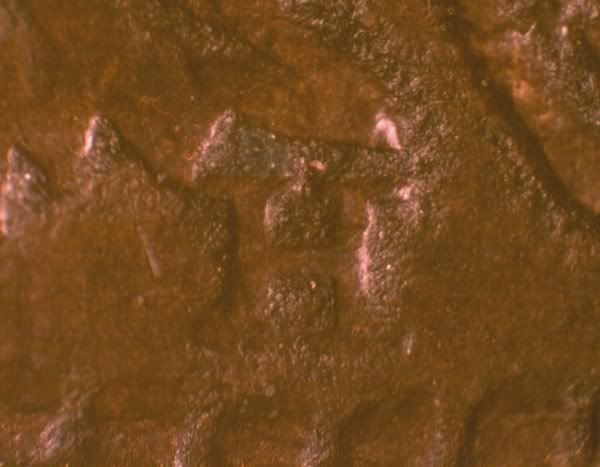 |
| H is high left with the upper left serif of the H touching the tip of the lobe of the leaf. |
 |
| H is far left with the top of the upper left serif touching the tip of the lobe of the leaf. This actually looks like a bridge from a die chip. |
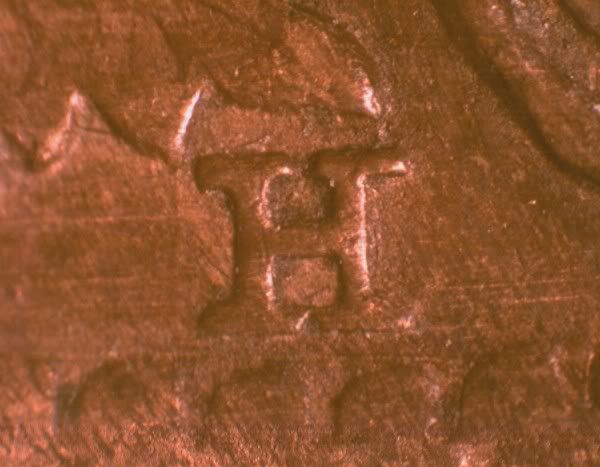 |
| H is high in relation to the tip of the leaf lobe. |
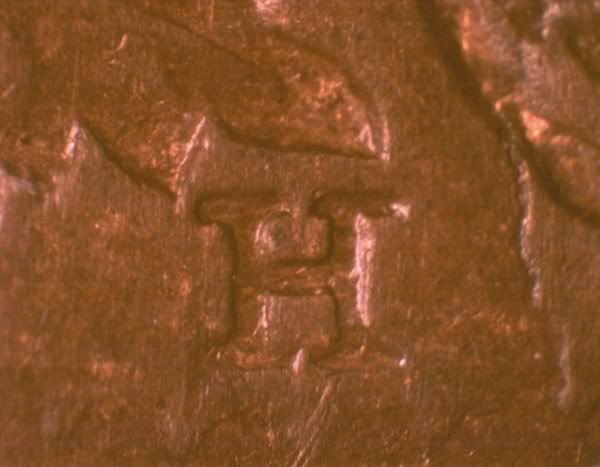 |
| H is even in relation to the tip of the leaf lobe. Note the die crack to the right of the H. |
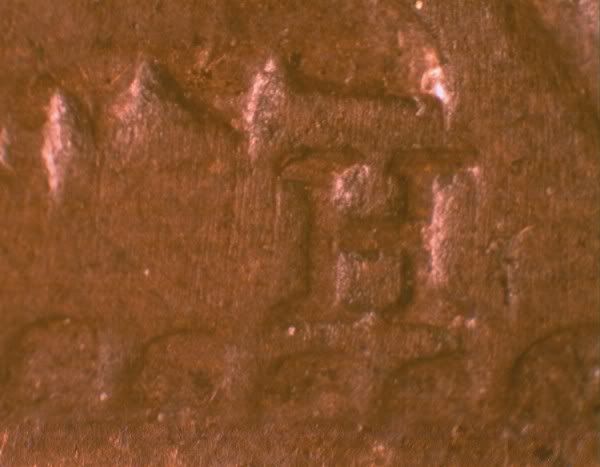 |
| H is low and far from the leaf to the right. |
 |
| H is low and far from the leaf to the right. Note the die crack in the H. |
Sunday, March 13, 2011
Protecting Your Cash
I was at the Chicago Paper Money show yesterday. This is always an intimidating experience for me, a large cent guy. All that paper, all those choices, radars, sequential, devils faces, foxing, bleaching, washing, pressing, discrete folds, different signatures, prefixes, suffixes, and me a green as grass when it comes to that stuff. My biggest fear is making a mistake and laying out too much cash for a common item. It got me thinking, the same is true when you are starting to collect Vickies.
I take it all in stride now, but we all started at some point. I was wondering on the drive home, what are the items that have bubbled to the top for me in evaluating whether to bring a coin home or leave it were I found it. There are so many things running through my head when I have a coin in hand. I can sit at a table in any bourse, or coin shop and very quickly decide if a particular item is coming home with me or if it will continue to live in “foster care”. This allows me to look at a lot of coins in a short period of time.
There is a lot of good advice out there and it can all swirl together when Vickie is staring at you, beckoning you to take her home. Some of the clichés that abound and are all true are; by the book first, by the coin not the holder, start with the keys, by the highest grade your budget will allow, don’t buy problem coins, and the list goes on. All good advice but when you are sitting at a table on the bourse and the coin is pleading with you, how do you decide what to do?
For me the first checkpoint I consider is the price on the holder. No other information is relevant. I don’t care if the coin is encased by the most or least respected third party grader (TPG), has nice typing on stickers, or is in a beat up old 2x2. I don’t care if the coin is under glass, in a ratty old 3 ring binder or beautifully organized in double row red boxes. The only info I consider is the price the vendor wants for the coin. I go to price first, so I can quickly use my other criteria to make a decision. My price point varies by year so I marry the asking price with the date on the coin, not the holder. The price at this stage doesn’t matter; it is just an information point.
My second checkpoint is damage, cleaning, etc. I try hard to leave scudzy coins where I find them. This is my first decision making criteria. Despite the price point, coins that are damaged, altered, corroded or that don’t have eye appeal go straight back where I found them for the most part. If I am not variety hunting I move on to grade. If I am looking for varieties, the coin will linger in my hand just a bit longer. More on this point in a moment.
Next comes grade. This I determine for myself. Too many collectors are not good graders. They accept TPG opinions without question. They look at the grade on the 2x2 and accept that. The vendor offers a verbal on the coin you have in your hand and it becomes an influencer. Learning how to grade is probably the single most important skill you can develop. You know more than you think. The more coins you look at for a particular denomination, the better you get. This skill is a must. If the grade I determine the coin to be and the asking price of the coin jive in my mind, she is still a candidate to come home with me. If not, back in the box she goes. This step implies a price point. I keep many in my head, but I also carry a copy of CCN Trends. I have allowed my price point to slide in the past and have been disappointed when I look at the coin at home, under proper light, released from the original 2x2 etc. I try hard not to talk myself into a purchase by allowing my price point to slide.
“Why this particular coin?” is my next question. What are my collecting goals? What am I after this trip? Where will this fit into my collection? Focus and discipline are key here. If not, you’ll find yourself out of money very quickly without advancing your collection. More coins do not a collection make. If your goals involve accumulating and hoarding that’s OK. If you are collecting, continue to exercise discipline. Know what you want before you set foot on the bourse or in the shop. So many coins to look at and so little cash in my pocket. I need to make sure I’m spending on my focus, not my distraction. I’m currently studying Obv. 1x coins so if the coin falls into that category, I may well buy her if she’s still in my hand after my grading exercise. If I’m variety hunting outside my study group, say 1858 or 9 as example, I then take a closer look for the markers. I’m continuing to only look at the coin. What is written on the holder continues to be completely irrelevant. To variety hunt you really need to either know the markers by heart, or have a good reference with you. Don’t pay variety money on someone else’s attribution. You need to be able to decide on your own. Here is the only time where a cleaned coin or minor scratch coin might persuade me to consider it.
Critically evaluate your performance once you get home. If you continue to be happy when you are looking at your purchases under your ideal home conditions, you have had a good day. If not then you need to learn from the mistake and improve your decision tree for next time. I have found that my spouse can help me here. Her question of “What did you pay for that old cent?” is a great opportunity for me to explain my selection criteria. If it passes muster, then Vickie is welcomed into her new home, if not she will get sold out of my collection and I’ll try again another day.
Being able to grade and determine varieties for yourself goes an incredibly long way to protecting your outlay of cash. The more knowledge you possess the better you get at advancing your collection. Develop your skill and stay focused. Your collection will reward you with hours upon hours of enjoyment as you gaze into Victoria’s face.
Sunday, March 6, 2011
It’s a Very Cool Coin, But…
I have this great 1859/8 that found its way to me a few weeks back. I didn’t buy it on purpose; it was in a group of about 30 coins or so. I often buy groups like this. They keep me honest when I’m trying to establish the relative scarcity of varieties or die pairs. It’s hard to have good numbers if you are constantly cherry picking, so I often buy groups. The particular 1859, 9 over 8 in question was not identified up front, it was listed as a narrow 9.
I reached for Turners The 1858 Cents of Provincial Canada, Volume II where Rob documents each obverse, reverse and die pairing for the 1859/8’s. It turns out to be an RD3/OA1. The RD3 reverse is not that common but it’s not scarce either. Rob has identified it as having coined about 5% of the overall 9/8 mintage. The obverse on the other hand gets around a bit more. The OA1 obverse has coined about 8% of the 9/8’s and is also paired up with 2 other overdate reverses. Rob shows that this particular obverse is also associated with 3 different 1858 reverses, all of which are quite scarce.
Here’s the cool thing about this coin. It has a cracked planchet that is so severe, it looks like the coin is going to break right in half! As soon as I saw it I knew I would be keeping the coin. The crack is right through, edge to edge, and shows clearly on both sides. I’m not exactly sure what’s holding it together. From the edge of the coin, the crack splits L3 in the middle, runs between the E of ONE and the T of CENT, splits the 5 and the 9, bisects L8 and out to the rim. Flipping the coin over we pick up the crack at the rim splitting the first A in CANADA, straight up Vicky’s neck, across her jaw, through her cheekbone, exiting about mid nose, and on to split the A in VICTORIA and out to the edge. This is a great break and it will make a great conversation piece.
OK here’s the rub. I’ll always have to describe the coin with the word “but”. “Hey, have a look at this 9/8. The planchet is seriously cracked. It’s very cool, but someone cleaned it.” I say. Yeah that’s too bad. A great piece and a sought after die pair, what a shame” you lament. “But that’s not all” I say, “look closer and you’ll see someone took what looks like an awl to the coin and marked it up, both sides”. “Man, that’s too bad” you say, handing it back.
In this case I’m able to live with the “but”. I didn’t put out 9/8 money for the coin. It was a surprise in a bulk lot. If I had however shelled out the cash for that coin individually, I can tell you that each time I looked at it, the cleaning and the defacing would bug me to the point that I wouldn’t show it to anyone. Sooner or later I would get rid of it and be done with it. How do I know this? It’s because I have bought coins in the past that had that effect on me. I should have left them at the coin shop, show or walked away from the auction before I was high bidder. I get no pleasure from a coin that I have to describe with the word “but”.
I know a dealer that says there is an owner for even the most scudzy coin. That might be so, but I’m trying hard to make sure it’s not me. Leave those scudzy ones where you find them if you’re anything like me. You will cringe every time you have to apologize for the look of your coin. Here is my scudzy 9/8 with the really cool broken planchet. Click the photos for a better look, if you dare.
Saturday, February 19, 2011
The Collectable Clash
I like die clash markings. No getting around it, I’m fascinated by the “extra design elements” on the coin. There isn’t a date in the Victoria series that doesn’t have a visible clash on some coins. I can’t keep them all, so what’s collectable? For me it’s the unusual ones.
I stumbled on clashes by accident. I wasn’t looking for them but they just started to pop out at me. Knowing where to look is the key to finding cool ones. Knowing where to look comes from knowing how a clash occurs . Let’s explore that first and then move on to the cool stuff.
We all know how dies clash together, the planchet fails to show up between the dies when the striking motion occurs. This can impart design elements from one die to the other. The operative word here is “can”. Even if design elements are transferred, they can be polished out of the dies or just plain worn out with use. So what do I mean by the phrase “can be transferred”?
Thinking this through a bit leads us to consider the designs on the dies, and what happens when they come together. First, the dies design elements are mirror images of what we see on the coin. Second, what is raised on the coin is incuse on the die. When the dies strike a planchet with appropriate force, the metal on the planchet flows into the incuse areas of the dies creating the raised elements of the coin. When the two dies come together without a planchet in between, there are 3 possible outcomes:
1. Field to field - Since no design elements are present, no design is transferred
2. Design to design - Since both elements are incuse there is nothing to transfer
3. Design to field – Ah, now something happens. The field from one die flows into the incuse area of the other die creating a raised element in the field of the first die.
Since the resulting new element is a raised spot, or high point, in the field on the die, it will impart an incuse element on the coins produced after the clash of the dies. The results are the markings I look for. The real cool ones I keep.
So what is there to look for and where do you need to look? Since the design elements of a die are mirror images of what is on a coin, we need to think in mirror image to visualize the impact areas on a coin. Look in the fields of the coin for these incuse design elements. The two overlay graphics below will help you peg the areas to look for and what design elements you can expect. You will often need to tilt the coin back and forth against a fixed light source in the same manner that you would check for luster. This will cause a clash to “pop”. Start looking for cool die clashes to add to your variety collection. You’ll be surprised at what you will find.
I had originally published the photographs of clash examples used below in the CN Journal , Vol. 53 Number 2, March 2008.
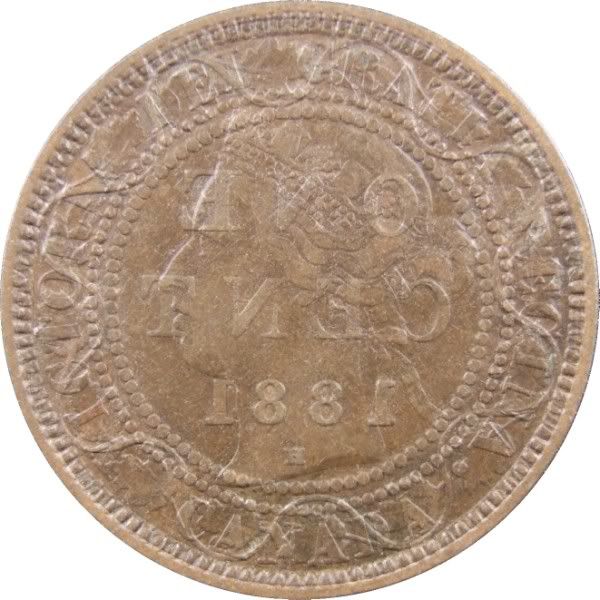 | ||
| Potential reverse element locations on the obverse side of a coin due to a clash. These will only be in the fields. |
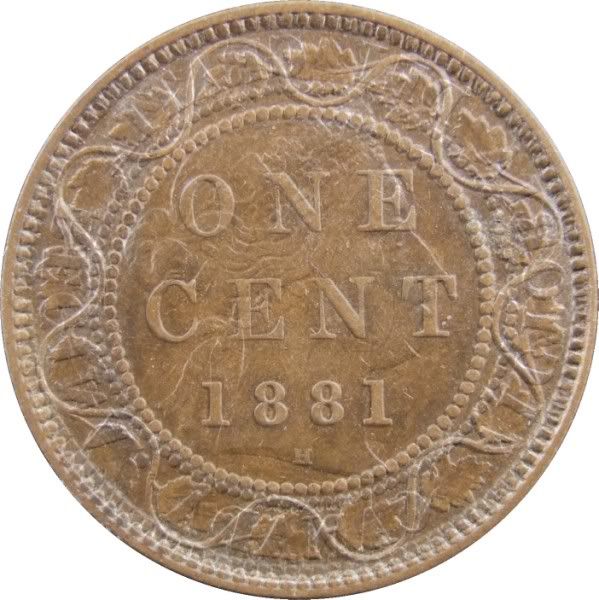 |
| Potential obverse element locations on the reverse side of a coin due to a clash. These will only be in the fields. |
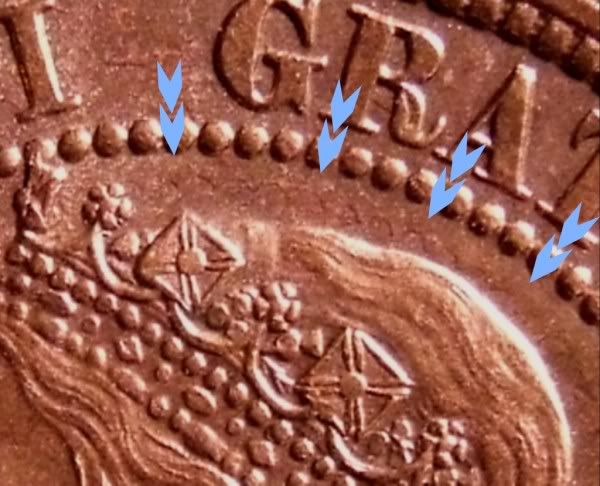 |
| Reverse bead clash between head and obverse bead line. This is fairly common. |
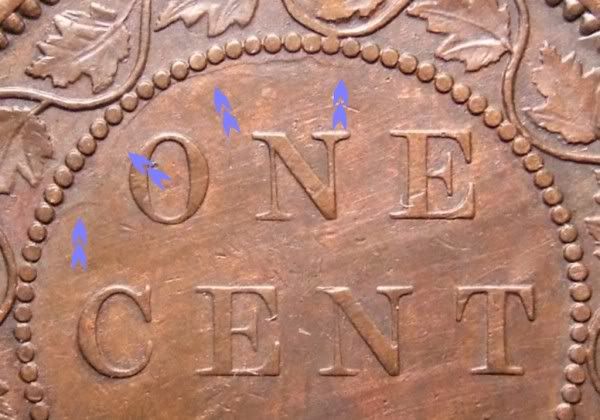 |
| Obverse head clash just under the bead line. This is fairly common. |
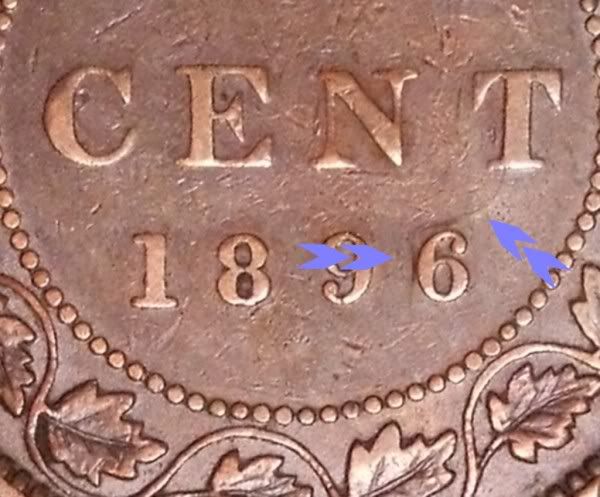 |
| Throat and chin clash. Note how it wraps the 6. These are less common. |
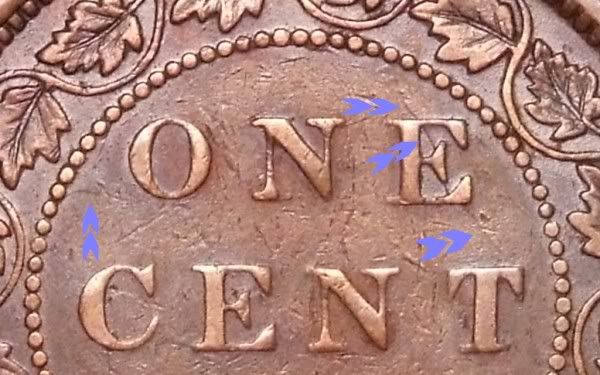 |
| Forehead and nose clash on the right, bun clash on the left. These are less common. |
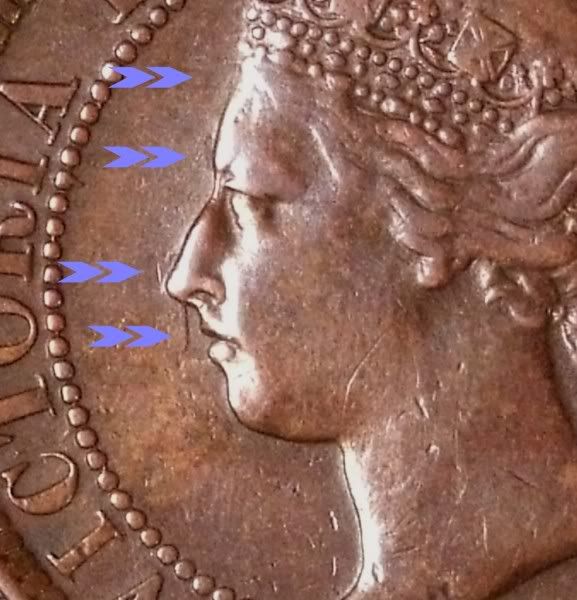 |
| E and T clashes. E sticking out of the forehead, the T from the nose and lips. These are fairly scarce. |
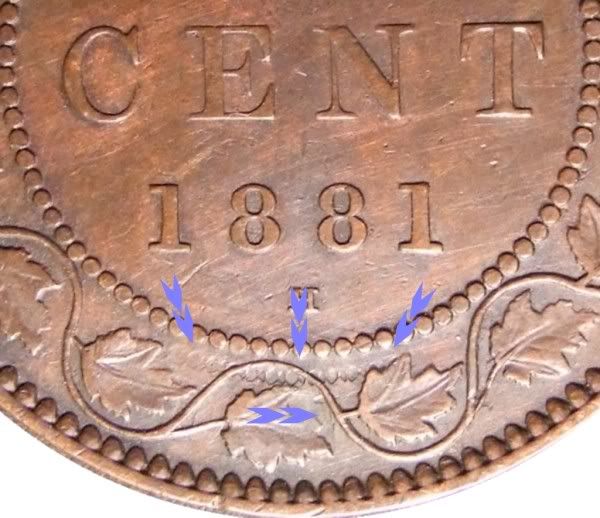 |
| Obverse beads and lettering in the leaf and vine line. This particular one is quite scarce. |
Subscribe to:
Posts (Atom)


